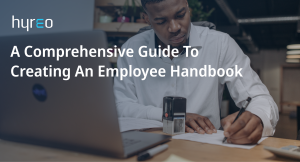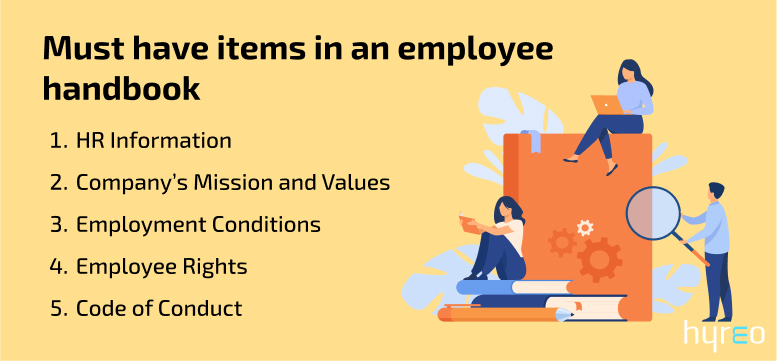Every company has its own set of rules and policies to abide by for the continuous success of the company. It is this set of rules that in turn defines its underlying work culture and employee expectations. However, it goes without saying that verbally conveying these policies during the employee onboarding process may not always be enough, and a more formal representation would go a long way.
An employee handbook is a handy booklet and can be unarguably the best representation of a company. The handbook can be a guide for employees to comprehend the values of the company, thus, empowering them to contribute to the company’s welfare. As such, it provides important information that eases the onboarding process of new recruits.
This blog will help you understand all the particulars of an employee handbook and its purpose, and relevant content, while at the same time exploring a few examples of the same.
What Is an Employee Handbook?
An employee handbook is a straightforward guide to assist employees in understanding the work culture of a company. It contains quick briefs about the conditions of employment, workplace policy, employment agreement, employment laws, and employment relationships to achieve a positive work culture. This makes a difference by creating an environment conducive to personal and professional growth.
It also provides an outlook on workplace issues and established norms of anti-harassment policies to ensure a safe environment for its employees. Maintaining transparency in a company can help retain employees for a longer duration and boosts the best outcomes. In other words, an employee handbook has to contain clear and understandable content for its employees, as unclear employee policies may cause severe liabilities.
Why Does a Company Need an Employee Handbook?
An employee handbook serves as a valuable communication resource for a company’s general guidelines and the policies to be followed for better functioning of the company. In fact, recent research has concluded that 87% of small-sized businesses have employee handbooks. Here are the top three reasons why companies should hand out employee handbooks for new recruits:
- It helps the employees better understand the privileges and obligations of their employment.
- A handbook can benefit the employee and the employer by compiling the organization’s policies as a book of proof in case of legal issues and poor compliance.
- HR experts believe that handing over an employee handbook to every new employee makes a secure organization and forbids any negligence.
How to Create an Employee Handbook?
Some great techniques to be followed while creating a handbook are
- Emphasizing core values
- Adding engaging imagery
- Limiting corporate jargon
- Multiple slides/pages to elaborate information
- Avoiding fluff
- Administering humor
8 Must have items in an Employee Handbook?
Creating a handbook by keeping in mind the following details can make it resourceful for the employees.
#1 HR Information
No matter the size of the company, be it an up-and-coming start-up, a medium to large enterprise, or a new-age work-from-home/hybrid work environment basic HR information is a must! Having basic company HR policies with regard to processes for leaves, travel allowances, and other perks not only saves time but allows employees to plan accordingly. Moreover, it may be a good idea to include your HR’s contact information in your handbook so that your team members are facilitated quick access to their HR during unexpected circumstances.
#2 Company’s Mission and Values
Missions and values instill a sense of character in a company. It is a must to mention the same in the handbook to help the employees put together good teamwork for the success of an organization.
#3 Equal Employment Opportunity
Equal employment opportunity allows every employee to showcase their talents irrespective of their gender and years of experience. It helps them pitch new ideas and suggestions without fear. This can help the organization to implement practical ideas and accept realistic expectations and changes that may favor all.
#4 Employment Conditions
Employment conditions are the terms and policies to abide by the employee onboarding the company. It is preferable to maintain a signed digital copy of the terms and conditions for future reference.
#5 Employee Rights
The handbook should clearly state the employee rights as per the legislation law. Employees are entitled to work in an environment free from any form of discrimination and have the right to fair remuneration.
#6 Employee Benefits and Compensation
Employee benefits are essential to keep the employee motivated and perform better. Employee benefits must include bonuses, appraisals, and gratuities provided by the organization based on the overall performance of the employee. It is common for employees to be forgetful of the policies mentioned at the time of the interview. Referring to the handbook can give an instant solution to the problem.
#7 Dress Code
Basic grooming and cleanliness are expected from each employee. To avoid unnecessary workplace dramas and to maintain professionalism, a dress code customized to each organization can set their employees apart from others. A professional outlook is expected in most organizations.
Dress codes can vary depending on the nature of work and the type of organization. For instance, some organizations implement uniforms as a type of marketing to their audience and to establish their company. However, few organizations encourage the freedom to wear casual clothes to work to bring about a friendly environment.
#8 Code of Conduct
A code of conduct determines the behavior and attitude of an individual under pressure and stressful conditions. Every employee is accountable for their own actions. Promoting accountability through honesty and open and professional communication results in great relationships and teamwork. It is a roadmap to the company’s culture.
#9 Company’s Grievance Policy
A grievance policy gives the employee the right to file a complaint in case of unpleasant assignments and unfair paychecks. This helps the employer to thoroughly investigate the issues and come up with a prompt solution. As companies grow, there may arise unchecked accumulation of power that can lead to exploitative practices on subordinates. With a grievance policy in hand, voicing out such concerns can expose and better accommodate such issues immediately.
#10 Health Benefits
Most companies provide insurance plans but some never make the effort to explain them in detail. Creating proper awareness about the health benefits granted to an employee can help them use them more diligently.
#11 Holiday Calendar
A holiday calendar lists the number of holidays an employee is eligible to take up in a year. It includes paid leave, sick leave, and national, cultural, and religious holidays.
#12 Anti-Sexual Harassment Policy
The most productive and satisfying environments are those in which work is accomplished in the spirit of mutual trust and respect. This makes a workplace free of sexual harassment important for the safety of the employees. With a proper set of law-binding policies in place, it guarantees employees a safe space free from discrimination and harassing conduct.
#13 Employment Termination Policy
Causes of employee termination are a grey area for most companies. While some terminate their employment voluntarily, companies may also fire employees based on myriad factors. A handbook is precisely designed to address such sensitive issues. It can clearly indicate the possible grounds that a company may act out to terminate a contract agreement or the repercussions of a voluntary termination from the employee’s side.
#14 Probation Period
The probationary period helps the employer to be prepared for any unexpected situations. It also allows the employer to terminate the contract in case of unsatisfactory performance.
Three Employee Handbook Designs of Famous Companies
Writing a handbook is definitely not an easy job. It takes time, effort, and due diligence to verify facts about the content to be published. To make it easy, listed below are a few examples of employee handbook designs that are a true inspiration for a good handbook.
#1 Netflix
The Netflix handbook is an effective one, with its guidelines on point to its employees. It educates the employee and helps grasp information on the go. It clearly states the values and the company’s culture that help with continuous success for many generations. The handbook lists down a few qualities like selflessness, honesty, passion, courage, innovation, and curiosity for its employees. To establish a great workplace, it expects its employees to respect and learn from each other.
#2 Valve
The employee handbook of Valve has taken a very candid approach. One that covers the root of its work culture and how everyone can question each other’s work. The best part being how it depicts light-hearted illustrations of the company’s norms and guidelines. This helps to project the necessary information to be followed by the employee for the smooth functioning of the company in a way that employees can easily consume the content.
#3 Sterling
Sterling is a mining company with a handbook that is colorful and pictorial. The handbook starts with a warm welcome from its CEO, followed by the guiding values, and also gives a valuable insight into the company’s history with significant moments chronologically arranged. The handbook also extends to elaborate the activities and tasks to be executed by an employee from the first day at work to their first month, thereby encouraging good communication, sharing perspectives, and questioning when faced with difficulties.
Feeling lost is quite common for a new employee, but this handbook has a solution for all. By sharing HR information and people to be contacted during emergencies or doubts, it saves the hassle. In addition, the handbook also carries information on work hours for employees from different categories and their leave eligibility. It is the best example of a good handbook with its details, clearly stated and good usage of various color palettes to add aesthetics.
Wrap Up
A good handbook is a compilation of regulations, ethics, and policies expected to be executed by the employee. Conveying content in a crisp and direct manner will give the handbook the attention it deserves. Updating handbooks once in two years and implementing new regulations can help in the betterment of the company.
Creating a handbook that takes into account the feedback and suggestions of the existing employees can add more essence to the content, and showcase the milestones achieved with teamwork. A company should be approachable and accessible, especially for its employees. Thus, an employee handbook can mirror the company’s goals and visions.
FAQs on Employee Handbook
What makes a good employee handbook?
A good employee handbook is simple, crisp, and clear and gives a detailed insight into the core values of the company. It has to mutually benefit the employer and the employee, with information on the company policies, leave allowances, health benefits, and safety precautions provided by the company. In addition, a handbook with comic illustrations and good colour palettes can keep it knowledgeable and interesting for its employees.
How does an employee handbook benefit the employer?
Establishing company policies in the handbook gives the employer the advantage to execute legal actions in case of immoral conduct and terminate employees with unsatisfactory performance. But more importantly, it helps prevent issues like this from arising altogether by eliminating instances where employees just didn’t know about certain policies, and repercussions.
Why are employee handbooks essential?
Employee handbooks are guidelines for the company’s ethics and policies. To maintain professionalism, following necessary rules and regulations can help support the decorum of a company.
Is it challenging to create an employee handbook?
Creating a handbook is simple with the help of various digital platforms and paid software. In addition, there are free sites that have professionally designed employee handbook templates to welcome new employees with style.
How often should a company revise an employee handbook?
Revising the employee handbook every two years is essential to incorporate new changes and eliminate the old ones for the company’s continuous growth.




